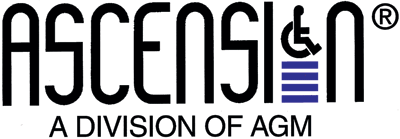Vertical Wheelchair Lifts: Specifying for Safety, Accessibility and Building Needs
![]() Continuing Education
Continuing Education
Use the following learning objectives to focus your study while reading this month’s Continuing Education article.
Learning Objectives - After reading this article, you will be able to:
- Identify requirements outlined in the ADA Accessibility Guidelines for Buildings and Facilities (ADAAG ) as they relate to vertical wheelchair lifts.
- Identify features relating to safety, visibility and autonomy in vertical wheelchair lift design.
- Assess vertical wheelchair lift products in terms of accessibility, portability and durability.
- Specify a vertical wheelchair lift that best meets client, user and building staff needs.
The wide variety of wheelchair lifts on the market for meeting ADA requirements present a challenge to specifiers because of the wide range of available design features addressing safety, durability and aesthetic needs.
Of the multitude of federal, state and local regulations relating to the design, construction, and alteration of buildings, perhaps none have had a greater impact than those required by the Americans with Disabilities Act (ADA) of 1990. Early on, architects puzzled over compliance and at least one signature building was brought up short when it was discovered that an entry lobby with steps required the last minute addition of a vertical wheelchair lift.
Since then, seminars, special bulletins and web-accessible government sources have helped clarify accessibility regulations and their impact on design for new construction and alterations. But an understanding of the equipment and products needed to meet both those requirements and the demands of building use are not so widely appreciated. This is especially true of vertical wheelchair lifts. Since there are a number of vertical wheelchair lifts on the market, a knowledge of applicability to ADA compliance, design features plus the demands and uses of each building is critical.
ADA requires that each service, program, or activity conducted by a public entity in a public accommodation or commercial facility, when viewed in its entirety, be readily accessible to and usable by individuals with disabilities. Guidelines to new construction and alterations projects covered by titles II (state and local government services) and III (public accommodations and commercial facilities) of the ADA are spelled out in ADA Accessibility Guidelines for Buildings and Facilities (ADAAG) (www.access-board.gov).
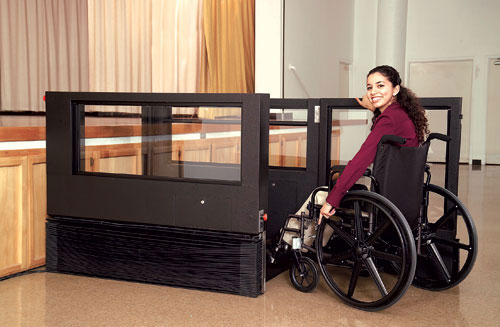 |
Portable vertical wheelchair lift with no machine tower placed to access a school stage Photo: Ascension |
In order to provide accessibility for people in wheelchairs, new construction generally requires the inclusion of an elevator. But alternatives for low-rise needs, such as ramps and vertical wheelchair lifts are permitted for both new construction and retrofitted existing facilities under certain exemptions in lieu of an elevator (see Sidebar, ADA Compliance, p. 3).
A portable or permanently installed vertical low-rise device that raises and lowers a wheelchair to places that would be otherwise inaccessible to a person in a wheelchair is known as a vertical wheelchair lift or vertical platform lift. (Lifts that carry wheelchairs up stairs are known as "inclined" wheelchair or platform lifts.) As an alternative to a permanent space-occupying ramp that seldom adds to design integrity or spending valuable time assembling a cumbersome portable ramp system, lifts are the optimal choice for adaptations of existing buildings and, often, new construction. Vertical wheelchair lifts are used to reach different levels of commercial and public buildings such as stages, platforms, or similar elevated surfaces. Numerous applications are found in schools, colleges and universities, convention centers, auditoriums, arenas, churches and synagogues, hotels, conference centers, parks and recreational facilities, casinos, historic buildings, courthouses, senior activity centers, outdoor amphitheaters, fairgrounds, commercial buildings, company offices, retail stores, museums, various institutional buildings and other government facilities.
PRODUCT DIFFERENCES
Since vertical wheelchair lifts must meet ADA guidelines, the major manufacturers have developed and tested all applicable operating and safety devices of their products for compliance. But vertical wheelchair lift design, applicability to differing building uses and ability to meet demands of clients vary considerably between manufacturers. Differences in products such as how they address some safety issues, portability, durability and aesthetics present building owners, facility managers, architects, and specifiers with a wide spectrum of choices ranging from the utilitarian to higher-end niche models. As is usually the case, higher-end niche models offer added value in operating features, aesthetics and durability.
A first step in the process of specifying a vertical wheelchair lift is to consider who will be using the lift and how often. In addition to wheelchair users, there are many other people who are temporarily or permanently unable to mount stairs. These include people using walkers or crutches, anyone with a medical condition that precludes climbing steps or even civil rights icon Rosa Parks who, in her later years, made her entrance on a Los Angeles stage through the use of a wheelchair lift. A vertical wheelchair lift intended for a school stage, say, should meet the needs of anyone unable to walk up steps.
Other users are service and maintenance staff. What are the demands on staff time for moving and activating a portable lift or maintaining a permanently installed lift; do they take away from other obligations?
It would appear that frequency of use should dictate the type of model needed. For instance, minimal use should justify the selection of an economical model. But amount of use should not be the only factor to consider. Reliability is a key demand because ADA requires accessibility equipment to stay in working order. When reliability, durability, length of warranties and ease of functioning are factored into life cycle costs, a higher-end model could be a better business choice.
PERMANENT OR PORTABLE?
One factor that may impact a decision regarding the selection of a vertical wheelchair lift is the requirement that permanently installed vertical wheelchair lifts must comply with building code requirements. Portable vertical wheelchair lifts, on the other hand, are considered equipment and are not required to meet building codes. It is worth noting, however, that some lower end portable vertical wheelchair lifts omit key safety features required for permanently-installed lifts, which could impact the safety of individuals in and around the lift. Therefore, a thorough product safety review is necessary when specifying a portable lift.
If a lift is needed for multiple locations within a particular building (convention center), or for relocation throughout an entire area (school district), specifying a portable model would be preferred over installing multiple permanent lifts. In small communities, such as Beloit, KS, a portable lift bought by the school district is often lent to the city.
Space and surface requirements
Specifiers should be aware that permanent and portable vertical wheelchair lifts need to be positioned to provide ADAAG floor and ground space requirements for wheelchairs. In addition they should note how much space a wheelchair lift occupies, since models on the market differ widely. A typical small footprint model takes up 5-1/2 ft of floor space in front of a stage, making it ideal for auditoriums or other venues with limited space between the stage and seating area.
Specifiers should also note ADAAG floor surface requirements for wheelchair lifts. The level change between the surface of the lower landing floor and the floor of the lift should not exceed ½ inch; a ramp must be used for level changes greater than ½ inch. Apart from that, any carpeting used is limited to a maximum thickness of half an inch. Furthermore, all edges of the carpet must be fastened down to the floor surface to prevent any incidences of tripping the wheelchair. (see Sidebar, ADA Compliance, p. 3)
ADA COMPLIANCE |
|
Major producers of wheelchair lifts manufacture their products to comply with ADA standards, noting that they are designed and tested in accordance with the following standards: ASME A18.1, ASME A17.5, ADAAG, ANSI A117.1, and NFPA 70 (NEC). Permanently installed wheelchair lifts must also comply with building requirements. Portable wheelchair lifts are considered equipment and are not required to meet building codes. The most recent version of ADAAG is found on the Access Board web site (www.access-board.gov) and the link (http://trace.wisc.edu/docs/adaag_only/adaag.htm). The U.S. Access Board (www.access-board.gov) has published a useful bulletin, BULLETIN 35: USING ADAAG to serve the specific needs of architects and other design professionals who must apply the ADA Accessibility Guidelines (ADAAG) to new construction and alterations projects covered by titles II (state and local government services) and III (public accommodations and commercial facilities) of the ADA. It is also intended to clarify accessibility regulations generally, including those that apply to existing facilities covered by the ADA. ADA guidelines (www.ada.gov) are published by the Department of Justice titledADA Accessibility Guidelines for Buildings and Facilities (ADAAG.) Wheelchair lifts are classified under 4.11 Platform Lifts (Wheelchair Lifts). Platform (wheelchair) lifts under ADAAG 4.11.2 must also meet Section XX ofASME A17.1-1990 Safety Code for Elevators and Escalators: theSafety Standard for Platform Lifts and Stairway Chairlifts. (Note: More recent versions of theASME A17.1 Safety Code do not include provisions contained in Section XX for platform lifts; these provisions are now provided in a new separate standard known as the ANSI/ASME A18.1-1999 Safety Standard for Platform Lifts and Stairway Chairlifts.) 4.11 Platform Lifts (Wheelchair Lifts).
New construction
|
 |
Minimum Clear Floor Space for Wheelchairs |
 |
Wheelchair lift with no access ramp allows user to enter the lift directly at floor level. Photo: Ascension |
Â
Portable vertical wheelchair lift
- Ideal for achieving program access in accordance with ADA requirements that include accessing a stage during events such as graduations or performances. A school facilities specialist in Florida points out that a portable lift eliminated the labor and material costs of building one-time-use ramps for graduations in three different locations. School rehabilitation specialist Thomas Himes with Architect Robert T. Scheeren AIA, Indiana, PA, finds a portable lift is the most viable and economical solution for providing required access, since installing a permanent lift usually involves additional alterations to the structure and many times requires space that is not available.
- Preeminent solution when clients want the versatility and convenience of a lift for multiple locations. The lift is used when and where it is needed and stored for the rest of the time. A typical compact model requires a storage space of only 48 inches x 66 inches.
- Immediately available for last minute access to stages.
- Plugs into the 120V building electrical power source.
- Requires minimal modifications to the using facility. "We were only required to modify a stair landing and supply an electrical outlet. Without the lift, we would have been forced to modify the whole west side of the gym," says the facility director of a Butte School District in Butte, MT.
- Storing a lift when not in use decreases maintenance costs for damage incurred when unauthorized people use a permanently installed lift for play.
- Does not need to meet building code requirements.
 |
Designed to be portable, this model rolls on its own casters, which can be quickly removed. Typical portable higher-end model can be transported by one person. Photo: Ascension |
Considerations
- How portable is portable?
- Is the portable lift originally designed to be portable, or is it really a fixed lift (i.e., meant to be permanently installed) that has been modified with some type of wheel undercarriage? A portable lift that was not originally designed to be portable may be less reliable than a lift that was designed to be portable from the ground up, because the manufacturer originally based component selection upon the assumption that the lift would always remain in one place. The stresses that a portable lift undergoes during transport between locations are different from the stresses born by a permanently installed lift.
- Some lifts that are moved by a tip-and-wheel method often need more than one person to safely transport them.
- A typical higher-end model designed to be portable is easily moved by one person and rolls on its own casters, which are then quickly removed. A lift that is easy to move allows facility staff to set up the lift for last minute accessibility requirements.
- Can a portable lift be safely used when moved to a new location? Michele S. Ohmes, ADA specialist, whose firm Michele & Associates provides consulting and training on accessibility issues, tells of riding a vertical lift that caught and lifted a flexible stage on its rise up. After seeing the podium wobble, she quickly reversed direction to safety. Some portable lifts have safety features to prevent a situation like this from occurring.
- Does the lift have height flexibility to reach the different stage heights within a facility?
The maximum stage height in most buildings is generally 60 inches. - What is the maximum width a portable model can pass through? Many older buildings are constructed with single 36 inch doors?
- One higher-end model can pass through openings of 48 inches; for smaller openings this unit can be compressed to 33 inches, using a simple tool kit, and pushed on its own casters.
- Portable lifts should be rugged and durable enough for a variety of applications.
- Should be weather-hardened for temporary outdoor use.
 |
Using a simple tool, this portable lift can be compressed to pass through doorways 36 inches wide. Photo: Ascension |
Permanently installed vertical
wheelchair lift
- Suited for any type of construction work where allowed by the ADA (new, renovations, modernizations.)
- Meets building code requirements that call for permanent accessibility.
Considerations
- Requires a building permit
- Some vertical wheelchair lifts require a pit at the lower level (approximately 3 inches deep) so that the entry surface of the lift is level with the floor (see paragraph on access ramps below), adding to the cost of installation.
DESIGN FEATURES
In terms of design, the most distinguishing feature of a vertical wheelchair lift is whether or not its drive mechanism is contained in an adjacent highly visible machine tower. The majority of vertical wheelchair lifts are equipped with towers that are part of their construction. Typical higher-end niche models are designed with no machine tower; drive mechanisms are self-contained within the platform side panels.
With a machine tower
- Towers often exceed 72 inches in height and can obstruct sight lines, which in turn may affect visibility for, say, people on stage or in the audience.
No machine tower
- A lift with no machine tower is completely self-contained and compact.
- Increases portability.
- Contemporary construction and design.
- No line of sight issues when using the lift for access to stage activities.
- More easily blends into the setting and does not detract from the architectural integrity of the building.
- Operation is typically smoother because the platform is lifted from both sides or from underneath (instead from only one side, as is the case with all lifts that have a machine tower).
 |
Vertical wheelchair lifts with and without a machine tower. Machine tower can obstruct sight lines. Image: Ascension |
With or without an access ramp
The transition from the lower landing level to the lift platform floor is critical to the usability of a wheelchair lift, and it is addressed in several different ways by lift manufacturers. This transition occurs because all lifts have some sort of supporting structure located under the platform floor which prevents the platform floor from sitting flush with the ground when the lift platform is at the lower landing, unless a shallow pit is provided to give clearance for the supporting structure.
Most fixed lifts, except for higher-end models, address this issue in one of two ways. The first is to provide a stationary access ramp in front of the lift door at the lower landing. A typical lift will require a 3 foot long ramp in order to accommodate a 3 inch offset between the landing and the platform floor with a 1:12 slope as required by the ADA. Additionally, because the ADA requires a 5 foot level landing in front of a lift door, that ramp must be offset from the door by 5 feet. Overall this leads to an 8 foot space in front of the lower landing lift door, which can be a problem if space is at a premium. Portable lifts are generally provided with an access ramp, except for high-end models.
The other way that this issue is often addressed on a fixed lift is by putting the lift into a shallow pit, so that there is no longer a vertical offset between the lower landing and the lift platform floor. This solution works well in new construction. However, when installing a fixed lift into an existing facility, the facility is required to create a new pit. This is often difficult and expensive, and sometimes impossible.
There is no problem-free way to place a portable lift in a pit, or to provide a 5 foot level landing between the access ramp and the lift entrance door.
The reason that wheelchair lift access ramps are so important is that the ADA requires that platform lifts facilitate unassisted entry and exit. However, an access ramp can make this transition difficult because access ramps, especially for portable lifts, tend to be quite steep. It is common for an access ramp to have a vertical elevation change of 3 inches over a horizontal distance of only 18-24 inches. This ramp slope exceeds the 1:12 slope allowed by the ADA, which can make it difficult or even impossible for most wheelchair-bound users to enter and exit the lift unassisted. Also, it is fairly common for a fixed lift to be installed with a ramp directly in front of the lower landing door in order to save space. However, this violates the ADA, which, as noted above, requires a 5 foot level landing in front of a lift door and makes access to the lift difficult
No access ramp
Some high-end lifts, both fixed and portable, eliminate the problem of an access ramp altogether by supporting the lift platform in such a way that it is possible to utilize a low-profile platform floor. This minimizes the offset between the lower landing and platform floor, thereby eliminating the need for an access ramp. This solution allows for the truly independent use of a portable lift and gives the building owner installing a fixed lift more flexibility in the installation.
- For portable lifts, it is possible to have a truly independent-use lift.
- When retrofitting an existing facility with a fixed lift, fewer building modifications are required because the lift does not need a pit.
- Decreases maintenance and service needs.
Transition at the upper level
How is the transition managed between the lift floor and the surface of the stage or upper landing sill?
- All fixed lifts have similar interfaces between the lift floor and the upper landing sill.
- More options are available in portable lifts. Some portable models include a hinged automatic dock plate for a smooth transition between the platform and the surface of the stage. This plate makes it easy for a facility's personnel to set the lift in place, since it bridges any gap between the upper landing sill and the lift floor. This plate also enables the lift to be used in front of stages with protrusions (e.g. architectural decorations), uneven surfaces, or stages with a curved fascia. Those lifts without a hinged dock plate are more difficult for facility personnel to set up correctly because they must be positioned with a relatively high level of precision to minimize the gap between the platform floor and the upper landing sill. A large gap is dangerous to users.
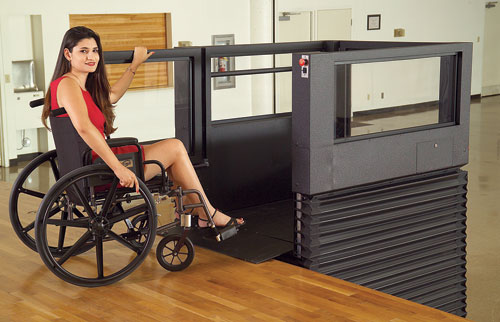 |
Lift showing automatic hinged dock plate for transition at the stage level. Photo: Ascension |
Â
Safety features
While ADA compliant lifts meet basic safety standards, different lift designs can present potential safety issues:
- Are the operating components completely enclosed for the safety of the passenger and public? A typical higher-end model uses durable safety skirting to completely enclose the operating components and the underside of the platform at all times during operation.
- If the underside of the platform is not protected by safety skirting or a solid steel enclosure, does the lift have a safety under pan to stop the downward motion of the platform if an obstruction is encountered as the lift descends? Some lifts omit the safety pan, but this is not permitted by the ASME A18.1 safety code.
- Is the user or the public protected from moving doors and flaps? Is there a railing inside the lift to hold onto? Exposed components and many moving parts increase the number of "pinch points," thus raising the possibility of the user and others getting extremities caught.
Dimensions of the lift sides and lift doors
- Noting that not all lift users will be in a wheelchair, are all four sides high enough for standing occupants to feel safe?
- Some lift designs do not have a lift door on the lower landing end. Instead they design the access ramp to tilt up and serve as a very low front to the lift. Not only could this make some standing users feel unsafe, it is not allowed by the ASME A18.1 safety code for platform lifts unless accompanied by an automatic barrier arm at a height of 35 inches.
- A minimum side height of 42 inches makes the lift safe for people on crutches or walkers. This height still allows the wheelchair user to see above the sides.Â
- Some portable lifts have no lift door on the upper landing end. This could lead to a shearing and crushing hazard when the lift is used at an open stage (such as a portable stage) or at a stage with an overhanging lip. Any part of the body that protrudes past the back edge of the platform floor could get caught under the overhang as the lift platform moves upward. This hazard is eliminated on a portable lift that includes a stage-side lift door that stands at least 6 inches higher than the stage level when the lift platform is at ground level. Such a door also prevents a wheelchair user on the stage from rolling off the stage and into the lift, and prevents the lift from being set up in such a way that it catches and lifts a flexible stage on its way up (because the lift will not fit under the stage). One higher-end portable lift is available with a door extender to ensure that the door is tall enough for any stage height.
- Some lifts are provided without solid side walls. The ASME A18.1 safety code requires solid sidewalls to prevent shearing and crushing hazards.
User visibility from inside the lift
Once inside the lift, can the user see to the outside?
- Some models with solid sides and doors provide no view to the outside, thus visually entrapping the user during the rising and lowering of the lift.
- Other models are designed with sides and doors fitted with high-impact transparent thermoplastic so the user can see out.
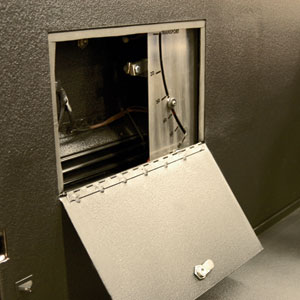 |
Height adjustment device that sets the upper travel limit of a portable lift Photo: Ascension |
Ease of setting the upper travel limit
The upper travel limit determines the location at which the lift platform will stop for the upper landing. The upper travel limit of a portable lift is adjusted every time the lift is set in place, so setting the limit should be both convenient and safe. One higher-end model uses an adjustment knob behind a locked panel. Facility personnel raise the lift platform to the upper landing, move the knob until it clicks into place, and then tighten the knob to hold the setting.
Platform size
- For a "straight-through" lift with the entrance and exit gates located on opposite ends of the lift car, so that the wheelchair user has a straight approach to the lift from both upper and lower landings, it is commonly accepted practice for the lift car inside platform dimensions to be a minimum of 36 inches x 48 inches. (See ADA Sidebar, page3)
- It should be noted that some scooters and oversized wheelchairs may be too long for a 48 inch long lift car. Choosing a wheelchair lift with a minimum inside car length of 54 inches will allow more users to utilize the lift.
- For wheelchair lifts designed with a "90-degree" or "side opening" configuration (i.e., the entrance and exit gates are located on adjacent sides), it would be reasonable to interpret the minimum platform size as 36 inches x 60 inches since the user would have a straight approach from one landing and a side approach from the other landing. This approach provides additional room for maneuvering.
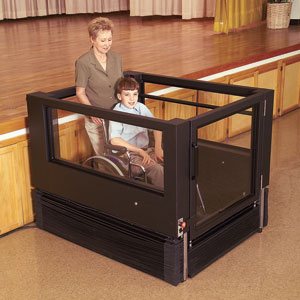 |
With transparent sides that are high enough to feel safe, users have a 360-degree view. Photo: Ascension |
Operating controls
- Models in compliance with ADA will meet requirements for controls and operating mechanisms that are operable with one hand, shall not require tight grasping, pinching, or twisting of the wrist and not require force greater than 5 lbf (22.2 N).
Noise of operation
- Can the wheelchair lift be used while an event on stage is in progress? Quiet operation with no rattles and shakes will not interrupt a performance or draw unnecessary attention to passengers. This enhances both the dignity of the passenger and the image of the facility. Lifts with hydraulic systems are typically much quieter and smoother than those with screw drive systems.
Aesthetics
Designers seek a wheelchair lift aesthetic that not only fits the building, but blends into the design of the auditorium or performance center. While some vertical wheelchair lifts have an industrial appearance, other lifts offer a higher level of aesthetic quality through a compact, clean, professional design with few visible moving parts. Again, an appealing appearance generally adds price points.
RELIABILITY AND DURABILITY
The reliability of vertical wheelchair lifts is critical, especially given their public visibility, as is their durability and need for maintenance. Specifiers should, therefore, welcome a quantifiable means for evaluating the reliability and durability of different models. One way is to peruse manufacturers' websites, learn how long a product has been on the market and read testimonials from purchasers who have used machines for at least four or five years. Another method of product evaluation is to compare warranties. Vertical wheelchair lift warranties range from 2 years for the drive train and 1 year for other components for most manufacturers, to 20 years for the drive train and 5 years for parts on higher-end models. Those choosing models with significantly longer warranty periods may safely expect that reliability is directly proportional to the length of the warranty period.
ENVIRONMENTAL RESPONSIBILITY
With owners and designers increased attention to long product life cycle and reducing the possibility of product obsolescence and eventual landfill waste, manufacturers generally provide information on their attention to Green issues. Some prevent landfill waste through a lift buyback program where used lifts are purchased from customers, reconditioned and re-sold at a discounted price. This program reuses a valuable piece of equipment that otherwise may have been discarded, while allowing a greater number of people to gain accessibility.
For those designers calculating LEED® points, a typical higher-end lift uses 39 percent recycled steel in its construction. Operating a lift does not require high amounts of energy. One manufacturer reports, for example, that each operation uses the same as a microwave oven or blow dryer. To determine energy consumed for operation, specifiers should consult the electrical requirements section in each product's specifications.
DRIVE SYSTEMS
- Most manufacturers' lifts have a capacity of 750 pounds [341 kg], although some have a capacity of only 500 pounds [227 kg]. Lifts rated for 500 pounds might not lift today's battery-operated wheelchairs or scooters which can be quite heavy.
- Typical vertical speed ranges from 7 feet per minute [2.1 meters per minute] to 17 feet per minute [5.2 meters per minute].
- Vertical travel capabilities of different models range from 12 inches [304 mm] to 72 inches [1829 mm] maximum lifting height. Stage heights vary, but most stages in public facilities do not exceed 60 inches.
CODE REQUIREMENTS (See ADA Compliance, page 3)
Major producers of vertical wheelchair lifts manufacture their products to comply with ADA standards, noting that they are designed and tested in accordance with the following standards: ASME A18.1, ASME A17.5, ADAAG, ANSI A117.1, and NFPA 70 (NEC). Permanently installed vertical wheelchair lifts must also comply with building code requirements. Portable vertical wheelchair lifts are exempt from the scope of both ASME A18.1 and ASME A17.1, the safety codes referenced in most building codes. Thus, portable lifts are exempt from building code requirements.
CONCLUSION
As with all design decisions, budgets are critical factors for specifiers. Safe, ADA compliant vertical wheelchair lifts are available in a wide range of prices. Will a low-cost model with a utilitarian aspect and 2-year warranty serve the client? Quite possibly yes, if the facility has very minimal use for a lift and a conscientious professional service staff. Or, quite probably no, if the facility is a convention center or school that requires the lift for a long life of multiple and demanding uses. In which case, a higher priced, higher end, ruggedly built model that also happens to be easier on the eye makes practical and budgetary sense. Concurring, Kenneth Otten, President of Dallas-based Otten Consulting Group, an accessibility consulting firm with more than a thousand clients across the United States, says, "We recommend higher-end no machine tower portable lifts exclusively because of their quality construction, ease of set-up and operation, superior maintenance record and first-class customer service." As always, design professionals should check each manufacturer's specifications for design and technical features.
|

